Abstract
Incompatibility group P plasmids demonstrate strong entry exclusion properties. Stringent incompatibility is also observed in the absence of entry exclusion. These observations have been facilitated by the study of a nontransmissible plasmid, RP1-S2, derived from RP1 by transductional shortening. RP1-S2 retains carbenicillin and tetracycline resistances as well as loci that cause either the loss of P plasmids (incp) or a locus specifying susceptibility to curing (sinp) in the presence of a P plasmid. RP1-S2 can be mobilized by an incompatibility group W plasmid, R388, and also freely forms recombinants with R388. P, N, and W incompatibility group plasmids all encode information for the receptor of the cell wall-adsorbing phage PRD1. Based on the premise that the location of this receptor is analogous to entry exclusion factors for F-like plasmids and hence a regulated transfer region determinant, we tested fertility inhibition relationships among these plasmid groups. We detected both reciprocal and nonreciprocal fertility inhibition relationships for bacteria containing various combinations of W, N, and P group plasmids. The nonreciprocal nature of some combinations, we believe, reflects the identity of the point mutation reading to derepression of the plasmid in question. Reciprocal fertility inhibition, on the other hand, may reflect the reconstruction of a fertility inhibition system through complementation. An X incompatibility group plasmid, known to affect the fertility of an N group plasmid, was also shown to inhibit P plasmid fertility. These observations may indicate a possible evolutionary relationship(s) of plasmids unrelated by the criteria of incompatibility, pilus phage specificity, or plasmid host range.
Full text
PDF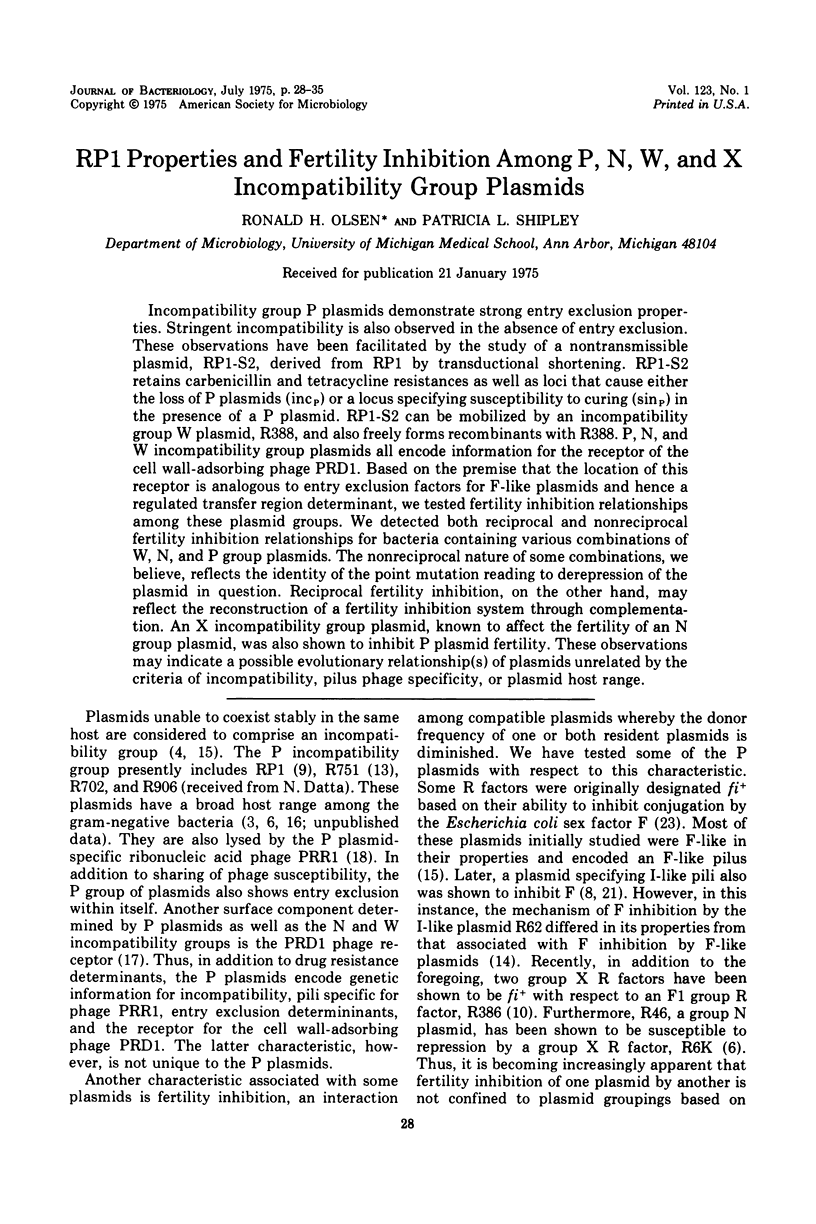
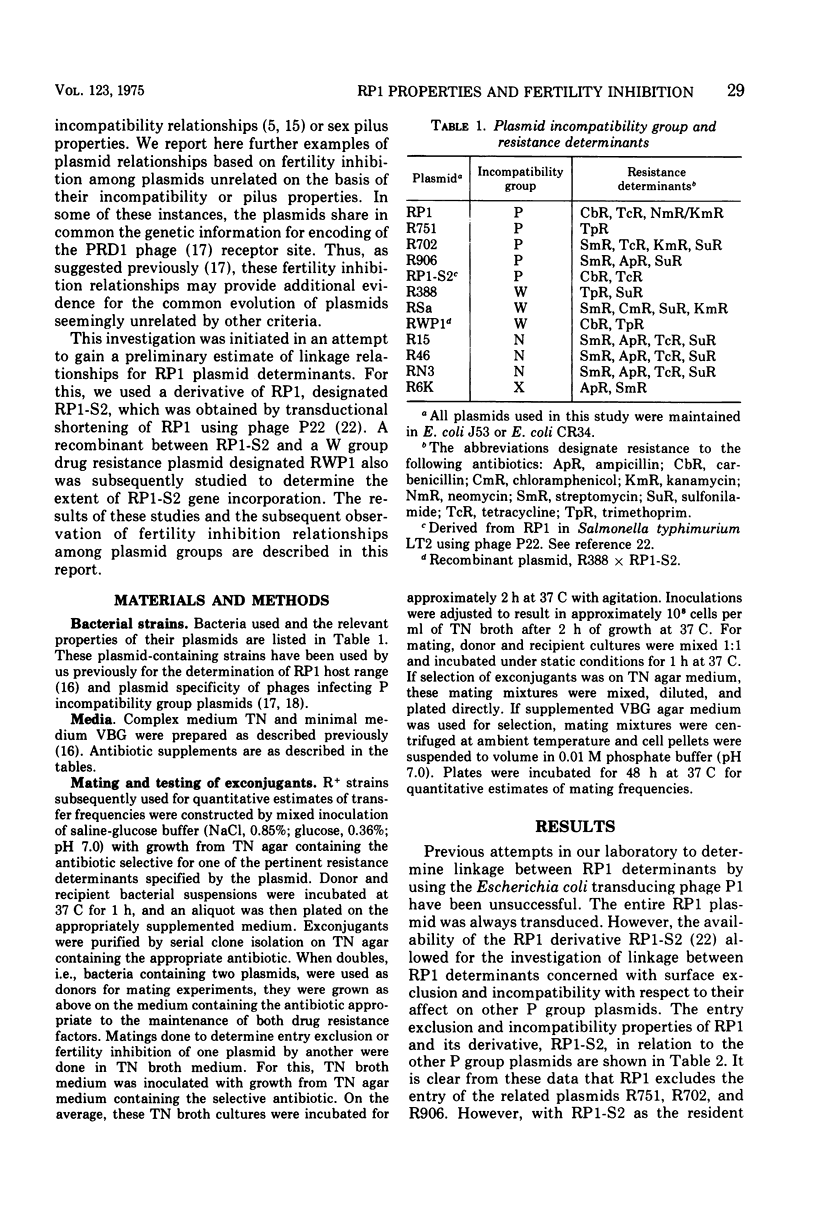
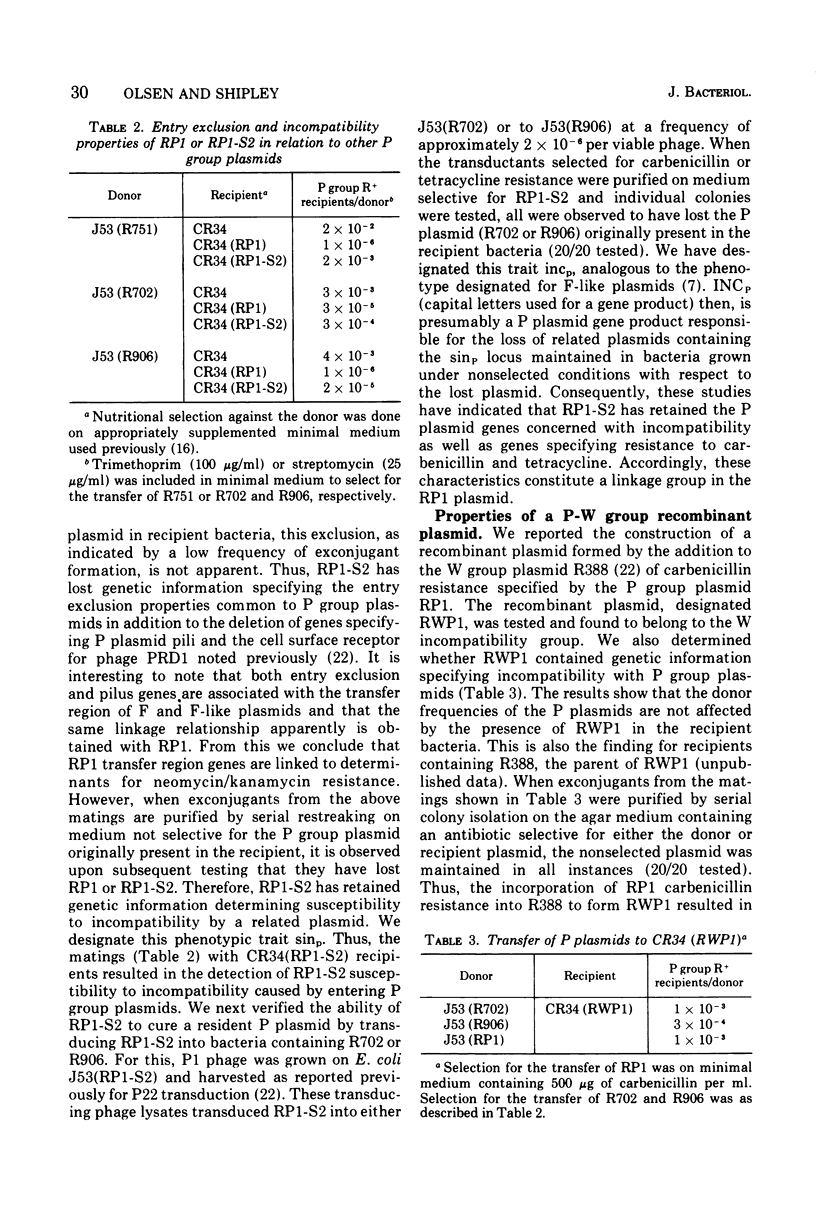
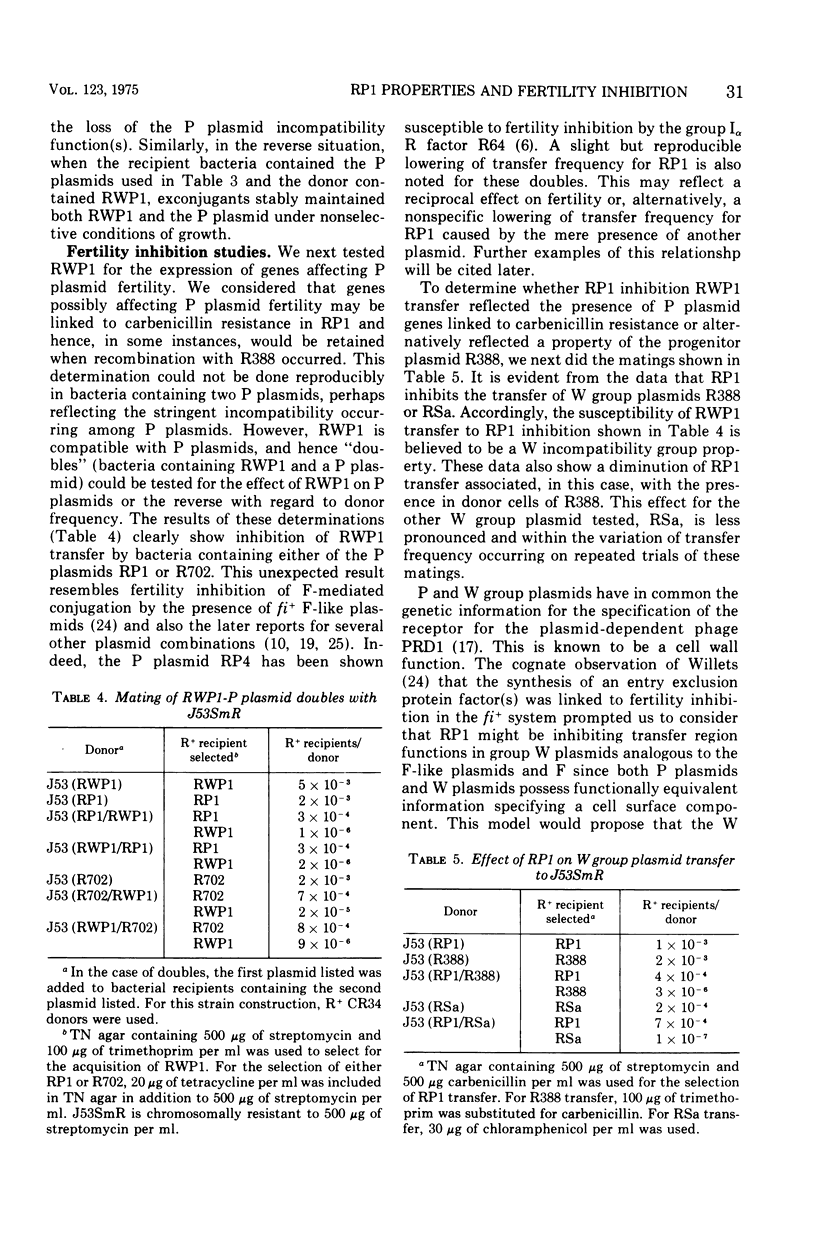
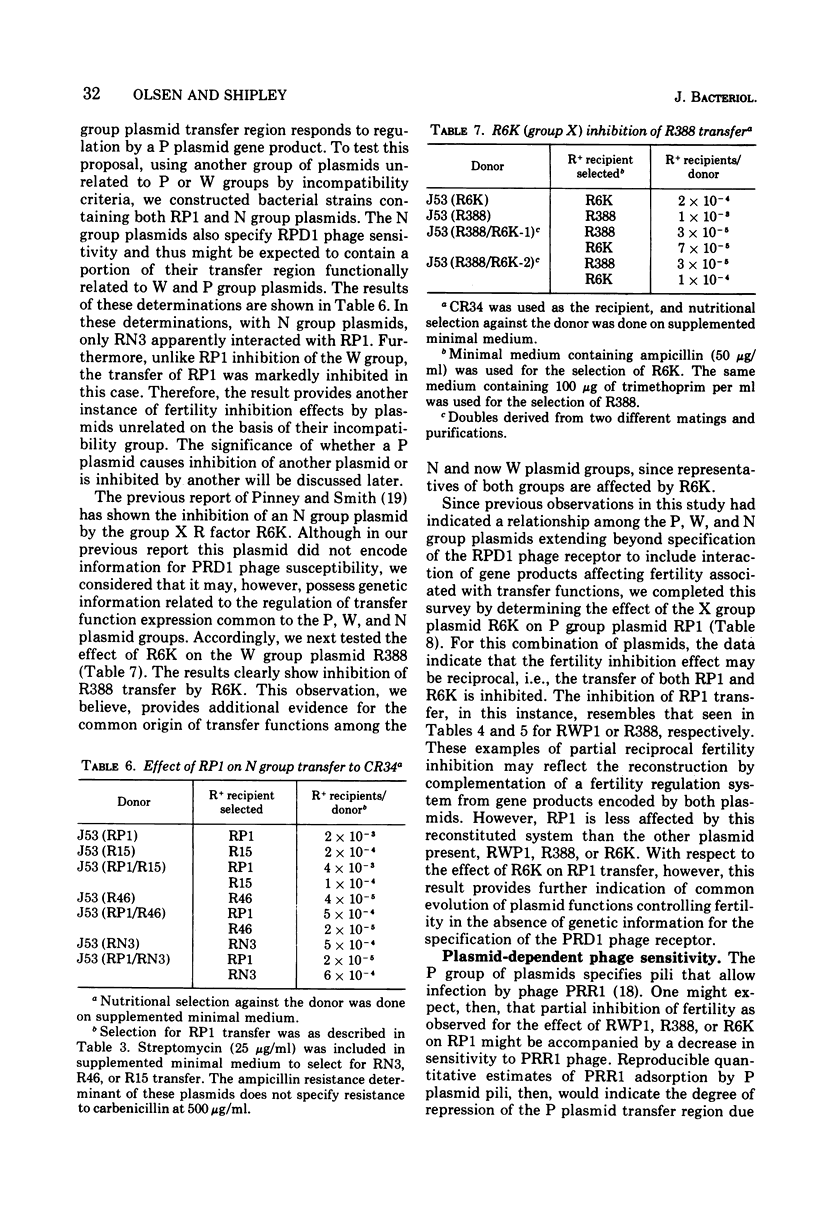
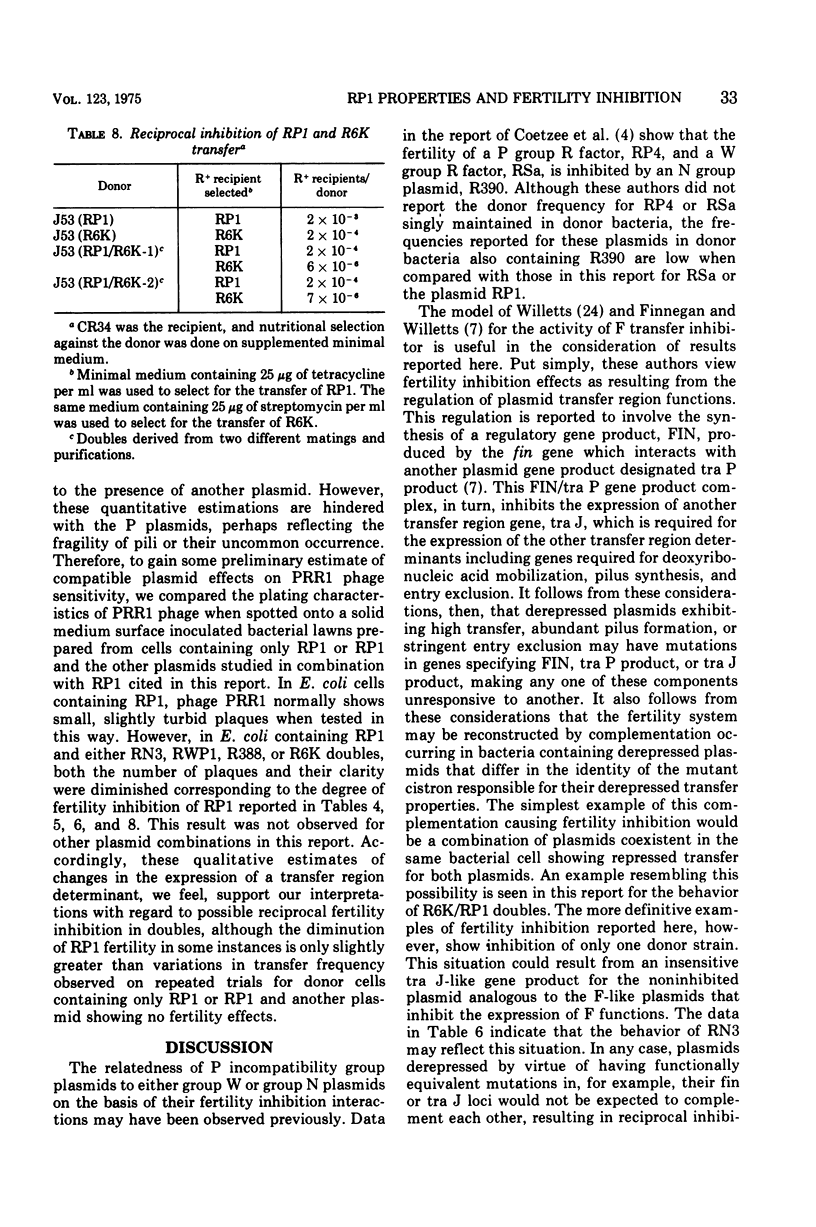
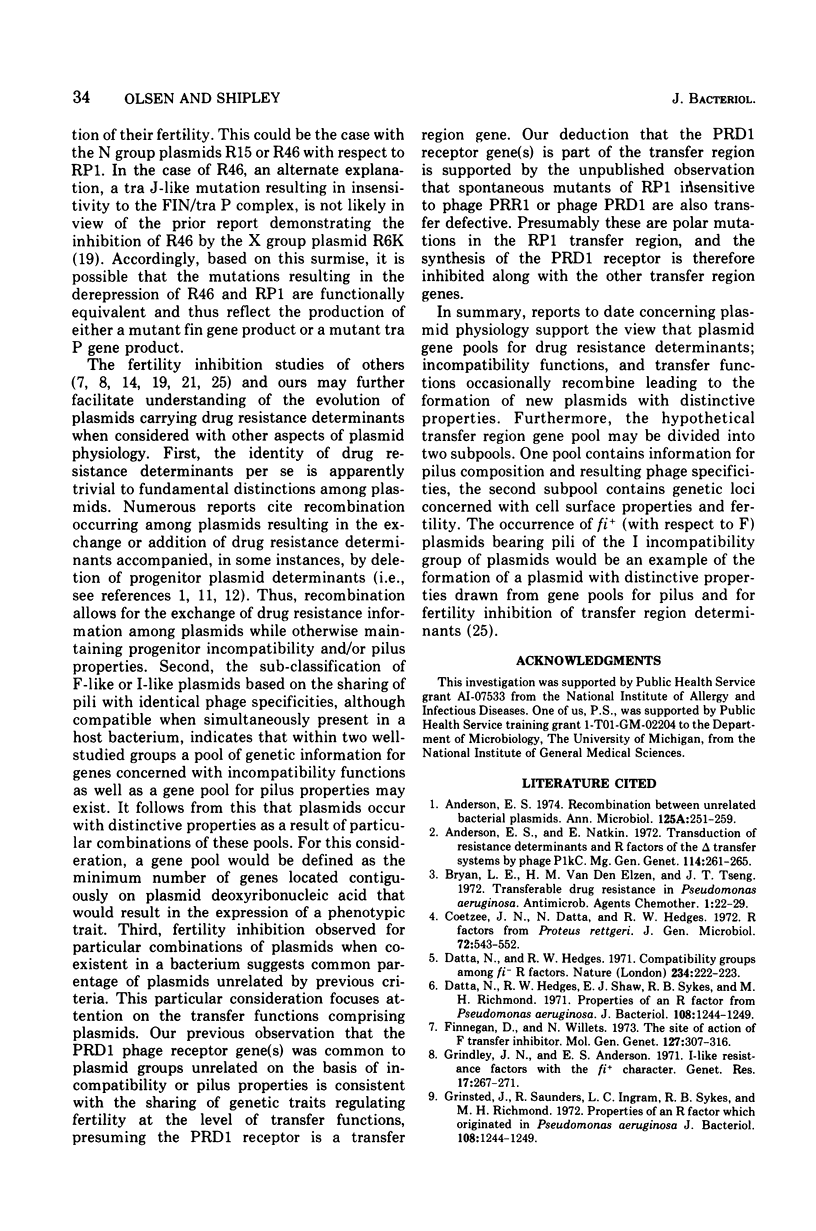
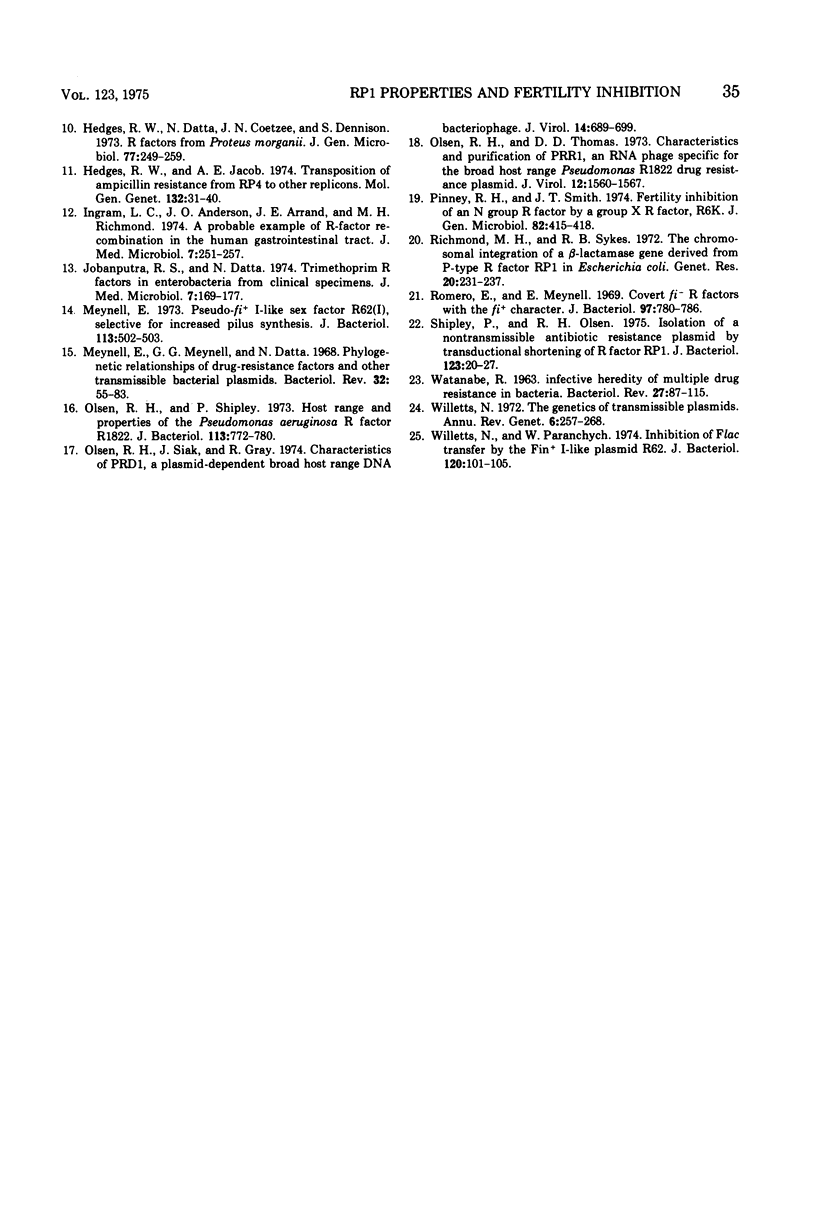
Selected References
These references are in PubMed. This may not be the complete list of references from this article.
- Anderson E. S., Natkin E. Transduction of resistance determinants and R factors of the transfer systems by phage Plkc. Mol Gen Genet. 1972;114(3):261–265. doi: 10.1007/BF01788895. [DOI] [PubMed] [Google Scholar]
- Anderson E. S. Recombination between unrelated bacterial plasmids. Ann Microbiol (Paris) 1974 Apr;125A(3):251–259. [PubMed] [Google Scholar]
- Bryan L. E., Van Den Elzen H. M., Tseng J. T. Transferable drug resistance in Pseudomonas aeruginosa. Antimicrob Agents Chemother. 1972 Jan;1(1):22–29. doi: 10.1128/aac.1.1.22. [DOI] [PMC free article] [PubMed] [Google Scholar]
- Coetzee J. N., Datta N., Hedges R. W. R factors from Proteus rettgeri. J Gen Microbiol. 1972 Oct;72(3):543–552. doi: 10.1099/00221287-72-3-543. [DOI] [PubMed] [Google Scholar]
- Datta N., Hedges R. W. Compatibility groups among fi - R factors. Nature. 1971 Nov 26;234(5326):222–223. doi: 10.1038/234222a0. [DOI] [PubMed] [Google Scholar]
- Datta N., Hedges R. W., Shaw E. J., Sykes R. B., Richmond M. H. Properties of an R factor from Pseudomonas aeruginosa. J Bacteriol. 1971 Dec;108(3):1244–1249. doi: 10.1128/jb.108.3.1244-1249.1971. [DOI] [PMC free article] [PubMed] [Google Scholar]
- Finnegan D., Willetts N. The site of action of the F transfer inhibitor. Mol Gen Genet. 1973 Dec 31;127(4):307–316. doi: 10.1007/BF00267101. [DOI] [PubMed] [Google Scholar]
- Grindley J. N., Anderson E. S. I-like resistance factors with the fi+ character. Genet Res. 1971 Jun;17(3):267–271. doi: 10.1017/s0016672300012295. [DOI] [PubMed] [Google Scholar]
- Hedges R. W., Datta N., Coetzee J. N., Dennison S. R factors from Proteus morganii. J Gen Microbiol. 1973 Aug;77(2):249–259. doi: 10.1099/00221287-77-2-249. [DOI] [PubMed] [Google Scholar]
- Hedges R. W., Jacob A. E. Transposition of ampicillin resistance from RP4 to other replicons. Mol Gen Genet. 1974;132(1):31–40. doi: 10.1007/BF00268228. [DOI] [PubMed] [Google Scholar]
- Ingram L. C., Anderson J. D., Arrand J. E., Richmond M. H. A probable example of R-factor recombination in the human gastro-intestinal tract. J Med Microbiol. 1974 May;7(2):251–257. doi: 10.1099/00222615-7-2-251. [DOI] [PubMed] [Google Scholar]
- Jobanputra R. S., Datta N. Trimethoprim R factors in enterobacteria from clinical specimens. J Med Microbiol. 1974 May;7(2):169–177. doi: 10.1099/00222615-7-2-169. [DOI] [PubMed] [Google Scholar]
- Meynell E., Meynell G. G., Datta N. Phylogenetic relationships of drug-resistance factors and other transmissible bacterial plasmids. Bacteriol Rev. 1968 Mar;32(1):55–83. doi: 10.1128/br.32.1.55-83.1968. [DOI] [PMC free article] [PubMed] [Google Scholar]
- Meynell E. Pseudo-fi + I-like sex factors, R62(I), selective for increased pilus synthesis. J Bacteriol. 1973 Jan;113(1):502–503. doi: 10.1128/jb.113.1.502-503.1973. [DOI] [PMC free article] [PubMed] [Google Scholar]
- Olsen R. H., Shipley P. Host range and properties of the Pseudomonas aeruginosa R factor R1822. J Bacteriol. 1973 Feb;113(2):772–780. doi: 10.1128/jb.113.2.772-780.1973. [DOI] [PMC free article] [PubMed] [Google Scholar]
- Olsen R. H., Siak J. S., Gray R. H. Characteristics of PRD1, a plasmid-dependent broad host range DNA bacteriophage. J Virol. 1974 Sep;14(3):689–699. doi: 10.1128/jvi.14.3.689-699.1974. [DOI] [PMC free article] [PubMed] [Google Scholar]
- Olsen R. H., Thomas D. D. Characteristics and purification of PRR1, an RNA phage specific for the broad host range Pseudomonas R1822 drug resistance plasmid. J Virol. 1973 Dec;12(6):1560–1567. doi: 10.1128/jvi.12.6.1560-1567.1973. [DOI] [PMC free article] [PubMed] [Google Scholar]
- Pinney R. J., Smith J. T. Fertility inhibition of an N group R factor by a group X R factor, R6K. J Gen Microbiol. 1974 Jun;82(2):415–418. doi: 10.1099/00221287-82-2-415. [DOI] [PubMed] [Google Scholar]
- Richmond M. H., Sykes R. B. The chromosomal integration of a -lactamase gene derived from the P-type R-factor RP1 in Escherichia coli. Genet Res. 1972 Oct;20(2):231–237. doi: 10.1017/s0016672300013732. [DOI] [PubMed] [Google Scholar]
- Romero E., Meynell E. Covert fi- R factors in fi+ R+ strains of bacteria. J Bacteriol. 1969 Feb;97(2):780–786. doi: 10.1128/jb.97.2.780-786.1969. [DOI] [PMC free article] [PubMed] [Google Scholar]
- Shipley P. L., Olsen R. H. Isolation of a nontransmissible antibiotic resistance plasmid by transductional shortening of R factor RP1. J Bacteriol. 1975 Jul;123(1):20–27. doi: 10.1128/jb.123.1.20-27.1975. [DOI] [PMC free article] [PubMed] [Google Scholar]
- WATANABE T. Infective heredity of multiple drug resistance in bacteria. Bacteriol Rev. 1963 Mar;27:87–115. doi: 10.1128/br.27.1.87-115.1963. [DOI] [PMC free article] [PubMed] [Google Scholar]
- Willetts N. S., Paranchych W. Inhibition of Flac transfer by the fin+ I-like plasmid R62. J Bacteriol. 1974 Oct;120(1):101–105. doi: 10.1128/jb.120.1.101-105.1974. [DOI] [PMC free article] [PubMed] [Google Scholar]
- Willetts N. The genetics of transmissible plasmids. Annu Rev Genet. 1972;6:257–268. doi: 10.1146/annurev.ge.06.120172.001353. [DOI] [PubMed] [Google Scholar]


